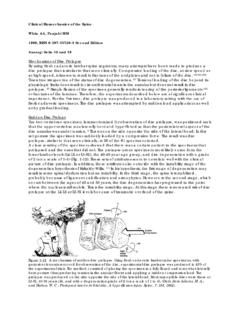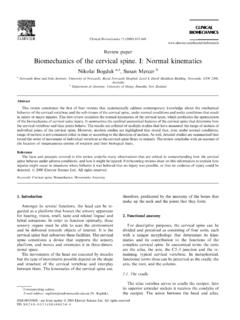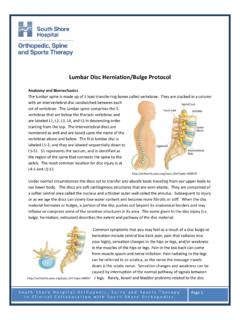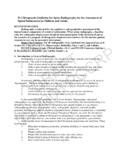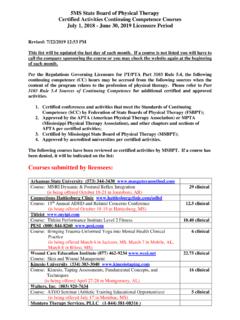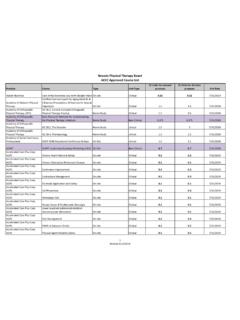Transcription of XYcor Expandable Spinal Spacer System - alphatecspine.com
1 XYcor Expandable Spinal Spacer System GENERAL INFORMATION: The XYcor Expandable Spinal Spacer System ( XYcor System ) is an intervertebral body fixation System consisting of implants with various widths, heights, and lordosis to accommodate individual patient pathology. The System implants are manufactured from implant grade titanium (Ti 6Al 4V per ASTM F136) and the instruments are manufactured from surgical grade stainless steel. The implants are intended for use with supplemental Spinal fixation; such as the Alphatec Spine Zodiac Spinal Fixation System , Aspida Anterior Lumbar Plating System , ILLICO MIS. Posterior Fixation System , ILLICO FS Facet Fixation System , the BridgePoint Spinous Process Fixation System , or the Arsenal Spinal Fixation System .
2 INDICATIONS: When used as an Intervertebral Body Fusion device, the XYcor Expandable Spinal Spacer System is indicated for Spinal fusion procedures in skeletally mature patients with degenerative disc disease (DDD) at one or two contiguous levels from L2 to S1. DDD is defined as discogenic back pain with degeneration of the disc confirmed by patient history and radiographic studies. These DDD patients may also have up to Grade 1 spondylolisthesis or retrolisthesis at the involved level(s). These patients should have had six months of non-operative treatment. The XYcor Expandable Spinal Spacer System is intended for use with autograft and with supplemental Spinal fixation systems and that have been cleared by the FDA.
3 When used as a Vertebral Body Replacement device, the XYcor Expandable Spinal Spacer System is intended for use in the thoracolumbar spine (T1-L5) to replace a collapsed, damaged or unstable partial or total vertebral body due to tumor or trauma ( fracture). VBRs are designed to restore the biomechanical integrity of the anterior, middle and posterior Spinal column, even in the absence of fusion for a prolonged period of time. The XYcor Expandable Spinal Spacer System is intended for use with autograft and / or allograft and with supplemental Spinal fixation systems and that have been cleared by the FDA. CONTRAINDICATIONS: The XYcor System is contraindicated for: 1. Active systemic infection or localized or Spinal infection; Morbid obesity.
4 2. Signs of local inflammation;. 3. Fever or leukocytosis;. 4. Demonstrated allergy or foreign body sensitivity to any implant materials;. 5. Any medical or surgical condition which would preclude or impede the potential benefit of Spinal implant and/or Spinal fusion surgery, which could include, but not be exclusive to, elevated erythrocyte sedimentation rate, unexplained inflammatory / disease processes, elevation of white blood cell count (WBC), marked left shift in the white blood cell count differential;. 6. Distorted anatomy, due to congenital or remote post traumatic/post infectious abnormalities;. 7. Conditions that may place excessive stresses on bone and implants, such as severe obesity or degenerative diseases, osteopenia, and/or osteoporosis (osteoporosis is a relative contraindication as this condition may limit the degree of obtainable correction and/or height restoration, the amount of mechanical fixation, and/or the quality of the bone graft).
5 INS-083B Page 1 of 10. 8. Any case in which a bone graft and fusion technique or where fracture fixation is not performed or required;. 9. Any operative case utilizing the mixing of dissimilar metals from different components;. 10. Patients having inadequate soft tissue coverage over the operative site or where there is inadequate bone stock, bone quality, or anatomical definition;. 11. Any case not described in the indications;. 12. Patients whose activity, mental capacity, mental illness, alcoholism, drug abuse, smoking, occupation, or lifestyle may interfere with their ability to follow postoperative instructions and/or activity restriction guidelines and who may place undue stresses on the implant during bony healing and may be at a higher risk of implant failure.
6 WARNINGS: The implants are provided sterile: a. Do not re-sterilize implants. b. Do not use implants if package is opened or damaged or if expiration date has passed. 1. Potential risks identified with the use of this intervertebral body fusion device, which may require additional surgery, include: device component fracture, loss of fixation, pseudarthrosis ( , non-union), fracture of the vertebra, vertebral endplate injury, neurological injury, and vascular or visceral injury. 2. The potential for satisfactory anterior column support is increased by the selection of the proper device size. While proper selection can help minimize risks, the size and shape of human bones present limitations on the size, shape and strength of implants.
7 Internal fixation devices cannot withstand activity levels equal to those placed on normal healthy bone. No implant can be expected to withstand indefinitely the unsupported stress of full weight bearing. 3. Implants can break when subjected to the increased loading associated with delayed union or nonunion. Internal fixation appliances are load sharing devices which are used to obtain an alignment until normal healing occurs. If healing is delayed, or does not occur, the implant may eventually break due to material fatigue. The degree or success of union, loads produced by weight bearing, and activity levels will, among other conditions, dictate the longevity of the implant. Notches, scratches or bending of the implant during the course of surgery may also contribute to early failure.
8 Patients should be fully informed of the risks of implant failure. 4. Mixing metals can cause corrosion. There are many forms of corrosion damage and several of these occur on metals surgically implanted in humans. General or uniform corrosion is present on all implanted metals and alloys. The rate of corrosive attack on metal implant devices is usually very low due to the presence of passive surface films. Dissimilar metals in contact, such as titanium and stainless steel, accelerate the corrosion process of stainless steel and more rapid attack occurs. The presence of corrosion often accelerates fatigue fracture of implants. The amount of metal compounds released into the body System will also increase. Internal fixation devices, such as rods, hooks, wires, etc.
9 , which come into contact with other metal objects, must be made from like or compatible metals. Avoid coupling of stainless steel with XYcor Spinal Implants. 5. This System has not been evaluated for safety and compatibility in the MR environment;. this System has not been tested for heating or migration in the MR environment. 6. The implants and instruments of Alphatec Spine product lines should not be used with any other company's Spinal systems. INS-083B Page 2 of 10. PRECAUTIONS: Based on the dynamic testing results, the physician should consider the levels of implantation, patient weight, patient activity level, other patient conditions, etc., which may impact on the performance of the intervertebral body fusion device.
10 1. The implantation of the intervertebral body fusion device should be performed only by experienced Spinal surgeons with specific training in the use of this device because this is a technically demanding procedure presenting a risk of serious injury to the patient. 2. Surgical implants must never be reused. An explanted implant should never be reimplanted. Even though a device appears undamaged, it may have small defects and internal stress patterns which may lead to early breakage. 3. Correct handling of the implant is extremely important. Contouring of this titanium implant should not be done. The operating surgeon should avoid notching, scratching or reverse bending of the implants. 4. Alterations will produce defects in surface finish and internal stresses which may become the focal point for eventual breakage of the implant.
